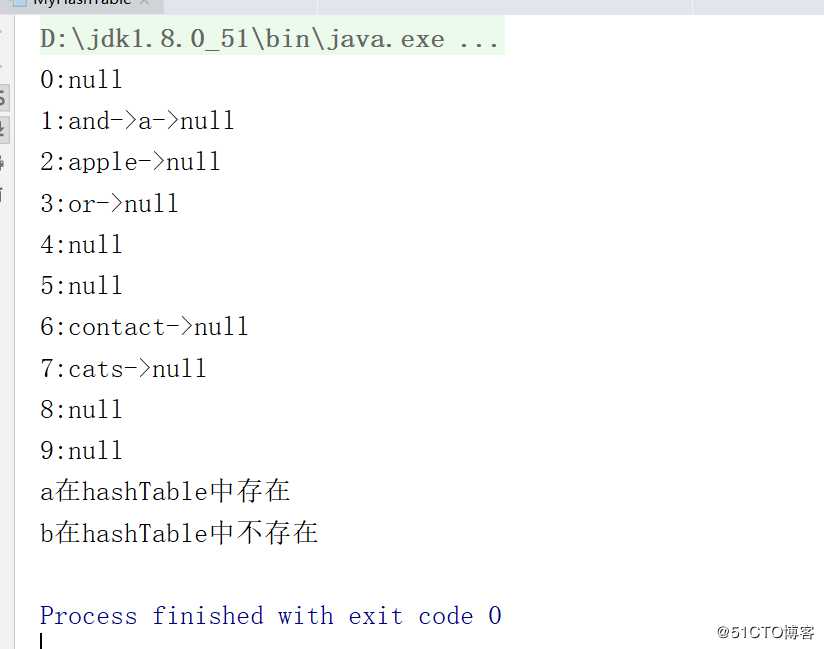标签:string EDA hash bre 编码 image 压缩 false 存在
HashTable存储单词存储单词的具体原理:将单词中的字母a到z分别对应1到26数字,空格为0进行自定义编码。根据编码规则,将单词中的每一个字母对应到相应的数字。利用幂运算得一个数字。比如:cats所对应的数字为
3*27^3+1*27^2+20*27^1+19*27^0=60337
这样得到了一个数值,如果将该值作为数组下标,10个字母的单词就有可能超过7000000000000,数字过于庞大,所以要压缩。为了方便显示,所以我将哈希表的长度设为10,即压缩到0到9范围内。但是又由于long类型范围的限制,最多只能存放长度为7个字母的单词。
下面是源代码
自定义链表节点
/**
* define single link list node class
*/
public class LinkedNode {
String dataItem;
LinkedNode next;
public LinkedNode(String data){
this.dataItem = data;
}
public String getNodeData(){
return dataItem;
}
}自定义单向链表
/**
* define Link List class
*/
public class SingleLinkedList {
private LinkedNode first;
private LinkedNode last;
int size;
//Constructor
public SingleLinkedList(){
first = null;
last = null;
size = 0;
}
public void insert(LinkedNode linkedNode){
if(first==null){
first = linkedNode;
}
else {
LinkedNode l = last;
l.next = linkedNode;
}
last = linkedNode;
size++;
}
public boolean searchSingleLink(String data){
LinkedNode i = null;
for(i =first;i!=null;i=i.next){
if(i.dataItem.equals(data)){
return true;
}
}
if(i==null){
return false;
}
return false;
}
public void displaySingleLinkedList(){
for(LinkedNode i = first;i!=null;i=i.next){
System.out.print(i.getNodeData()+"->");
}
System.out.println("null");
}
@Test
public void SingleLinkedTest() {
SingleLinkedList singleLinkedList = new SingleLinkedList();
LinkedNode linkedNode = new LinkedNode("a");
singleLinkedList.insert(linkedNode);
LinkedNode linkedNode1 = new LinkedNode("b");
singleLinkedList.insert(linkedNode1);
singleLinkedList.displaySingleLinkedList();
}
}
自定义hash表
public class MyHashTable {
int hashArraySize;
SingleLinkedList[] hashArray;
public MyHashTable(int capacity){
hashArraySize = capacity;
hashArray = new SingleLinkedList[hashArraySize];
for(int i = 0;i<hashArraySize;i++){
hashArray[i]=new SingleLinkedList();
}
}
public void displayHashTable(){
for(int i=0;i<hashArraySize;i++){
System.out.print(i+":");//display cell number
hashArray[i].displaySingleLinkedList(); //display list
}
}
/**
* * Alphabetical code table
* * 0 1 2 3 4 5 6 7 8 9 10 11 12 13 14 15 16 17 18 19 20 21 22 23 24 25 26
* * 空格 a b c d e f g h i j k l m n o p q r s t u v w x y z
* @param letter
* @return
*/
public int getLetterCode(char letter){
int letterCode = 0;
switch (letter){
case ‘a‘:
letterCode = 1;
break;
case ‘b‘:
letterCode = 2;
break;
case ‘c‘:
letterCode = 3;
break;
case ‘d‘:
letterCode = 4;
break;
case ‘e‘:
letterCode = 5;
break;
case ‘f‘:
letterCode = 6;
break;
case ‘g‘:
letterCode = 7;
break;
case ‘h‘:
letterCode = 8;
break;
case ‘i‘:
letterCode = 9;
break;
case ‘j‘:
letterCode = 10;
break;
case ‘k‘:
letterCode = 11;
break;
case ‘l‘:
letterCode = 12;
break;
case ‘m‘:
letterCode = 13;
break;
case ‘n‘:
letterCode = 14;
break;
case ‘o‘:
letterCode = 15;
break;
case ‘p‘:
letterCode = 16;
break;
case ‘q‘:
letterCode = 17;
break;
case ‘r‘:
letterCode = 18;
break;
case ‘s‘:
letterCode = 19;
break;
case ‘t‘:
letterCode = 20;
break;
case ‘u‘:
letterCode = 21;
break;
case ‘v‘:
letterCode = 22;
break;
case ‘w‘:
letterCode = 23;
break;
case ‘x‘:
letterCode = 24;
break;
case ‘y‘:
letterCode = 25;
break;
case ‘z‘:
letterCode = 26;
break;
}
return letterCode;
}
/**
* get hash code of word
* @param word
* @return
*/
public int hashFuc(String word){
long oldScope =0;
int newScope ;
int wordLength = word.length();
for(int i=wordLength-1,j=0;i>=0;i--,j++){
int letterCode = getLetterCode(word.charAt(i));
oldScope += letterCode* Math.pow(27,j );
}
newScope = (int)oldScope%10;
return newScope;
}
public void insertIntoHashArray(String word){
LinkedNode linkedNode = new LinkedNode(word);
int arrayIndex = hashFuc(word);
hashArray[arrayIndex].insert(linkedNode);
}
public void findWord(String word){
int index = hashFuc(word);
boolean b = hashArray[index].searchSingleLink(word);
if(b){
System.out.println(word+"在hashTable中存在");
}else {
System.out.println(word+"在hashTable中不存在");
}
}
}测试
public static void main(String[] args) {
MyHashTable myHashTable = new MyHashTable(10);
myHashTable.insertIntoHashArray("cats");
myHashTable.insertIntoHashArray("apple");
myHashTable.insertIntoHashArray("and");
myHashTable.insertIntoHashArray("a");
myHashTable.insertIntoHashArray("or");
myHashTable.insertIntoHashArray("contact");
myHashTable.displayHashTable();
myHashTable.findWord("a");
myHashTable.findWord("b");
}
结果

标签:string EDA hash bre 编码 image 压缩 false 存在
原文地址:https://blog.51cto.com/12721734/2434187